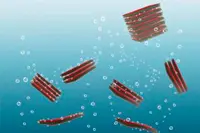 Drexel University researchers are testing combinations that may create faster, smaller, more efficient energy storage, advanced electronics and wear-resistant materials.
Drexel University researchers are testing combinations that may create faster, smaller, more efficient energy storage, advanced electronics and wear-resistant materials.
Led by postdoctoral researcher Babak Anasori, PhD, a team from Drexel's Department of Materials Science and Engineering created a material-making method that can sandwich 2D sheets of elements that otherwise couldn't be combined in a stable way.
"By 'sandwiching' one or two atomic layers of a transition metal like titanium, between monoatomic layers of another metal, such as molybdenum, with carbon atoms holding them together, we discovered that a stable material can be produced," Anasori said. "It was impossible to produce a 2D material having just three or four molybdenum layers in such structures, but because we added the extra layer of titanium as a connector, we were able to synthesise them."
The discovery represents a way of combining elemental materials to form the building blocks of energy storage technology such as batteries, capacitors and supercapacitors, as well as superstrong composites. The researchers suspect that one, or more, of these new materials will exhibit energy storage and durability properties so disproportional to its size that it could revolutionise technology in the future.
Combining two-dimensional sheets of elements in an organised way to produce new materials has been the goal of Drexel Nanomaterials researchers for more than a decade. Imposing this sort of organisation at the atomic level is no easy task.
But Drexel researchers have devised a way to circumvent this challenge. A material called MAX phase, which was discovered by Distinguished Professor Michel W. Barsoum, PhD, head of the MAX/MXene Research Group, more than two decades ago. It is said that all the elements of the finished product are in the MAX phase, waiting for the researchers to impose some order.
That order was imposed by Barsoum and Yury Gogotsi, PhD, head of the Drexel Nanomaterials Group, when they first created a stable, 2D layered material called MXene in 2011.
To create MXenes, the researchers selectively extract layers of aluminium atoms from a block of MAX phase by etching them out with an acid.
"Think of MXene synthesis like separating layers of wood by dunking a plywood sheet into a chemical that dissolves the glue," Anasori said. "By putting a MAX phase in acid, we have been able to selectively etch away certain layers and turn the MAX phase into many thin 2D sheets, which we call MXenes."
Prior to the discovery of MXenes, graphene was the first 2D material to be touted for its potential energy storage capabilities. But, as it was made up of only one element, graphene was difficult to modify in form and therefore had limited energy storage capabilities. The new Mxenes are said to have surfaces that can store more energy.
Drexel's team knows that, in principle, it can use this method to make as many as 25 new materials with combinations of transition metals, such as molybdenum and titanium that previously wouldn't have been attempted.
Anasori plans to make more materials by replacing titanium with other metals, such as vanadium, niobium, and tantalum, which could unearth a vein of new physical properties that support energy storage and other applications.
Author
Tom Austin-Morgan
Source: www.newelectronics.co.uk

